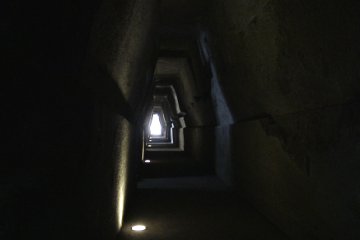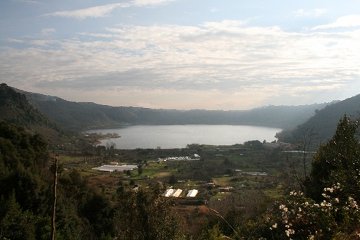The Golden Bough
| Cumae | 40 50 51.92N 14 03 11.27E | The entrance to the Cave of the Sibyl is in among the trees near the foot of the hill on which Cumae stands. |
| Nemi Lake | 41 42 42.03N 12 42 09.00E | I do not know exactly where on the shores of the lake Professor Coarelli was conducting his excavations. North of the lake, however, is the museumn which houses the Nemean boats. |
Some years ago I did a study of glossalalia, otherwise known as the phenomenon of "speaking in tongues". Of course, the Bible refers to this phenomenon, principally in Acts chapter 2, though there it is made clear that the "tongues" in question were languages that people understood. There was, however, a long tradition of "raving" in other religions and that is what I was researching.
For example, Herodotus tells the story of a certain king of the Scyths named Scylas who became interested in Greek culture and was initiated into the Mystery of Bacchus. Every year the Scyths would come to the town and the king would go alone into the city, get roaring drunk and go raving through the streets with the rest of the initiates. On one occasion he was seen by a couple of his fellow Scyths who reported to the rest of the tribe. Apalled that their king should be adopting the "soft" ways of the Greeks and making a fool of himself by "raving", the tribe promptly assassinated him and elected another king!
Actually, I was quite proud of my research, for that was in the days before the Internet. Today you could simply type "raving" into Google and, so long as you ignored all the references to modern dance trends, come up with the result. Back then I had to wade through many an ancient tome and dessicated reference book to come up with the information I needed. Among those books was the Aeneid by the Roman author Virgil.

| |
| Looking towards the entrance of the man-made tunnel that leads down to the Sibyl of Cumae. |
Aeneas was the Trojan prince who fled from the Greek sack of Troy and made it to his ship, along with a band of fellow refugees. He sailed off into the Mediterranean, where he eventually landed up at Carthage. There he had a brief love affair with Dido, queen of Carthage, but driven by a feeling of destiny, he abandoned her and sailed north to Italy. Still seeking divine guidance, he visited the Sibyl of Cumae in the vast cavern where she has her dwelling.
In these words the Cumaean Sibyl chants from the shrine her dread enigmas and booms from the cavern, wrapping truth in darkness - so does Apollo shake his reins as she rages, and ply the goad beneath her breast. As soon as the frenzy ceased and the raving lips were hushed, Aeneas the hero begins.
The Sibyl tells him that he must visit the Underworld, but to be sure of a safe return he has to take with him a present to Proserpine, the goddess of Hades.
There lurks in a shady tree a bough, golden leaf and pliant stem, held consecrate to Nether Juno [Proserpine]; this all the grove hides, and shadows veil in the dim valleys. But it is not given to pass beneath earth's hidden places, before someone has plucked from the tree the golden-tressed fruitage. This has beautiful Proserpine ordained to be borne to her as her own gift. When the first is torn away, a second fails not, golden too, and the spray bears leaf of the selfsame ore. Search then with eyes aloft and, when found, duly pluck it with your hand; for of itself will it follow you, freely and with ease, if Fate be calling you; else with no force will you avail to win it or rend it with hard steel.
It was with considerable interest, therefore, that I took my tour group to Cumae on a recent tour of Italy. We found that the entrance to the Cave of the Sibyl was as dramatic as Virgil claims - a 400' long, man-made tunnel descending apparently into the bowls of the earth. At the end there was a room where the Sibyl sat to await those who dared to come and consult her and as our voices echoed in the chamber, I couldn't help but consider how Aeneas and other suppliants would have felt, creeping in near darkness down the tunnel and hearing at the end the howls and shrieks as the oracle raved and raged. The hair must have well and truly stood up on the back of your neck!
The "Golden Bough" or "Golden Branch" which the Sibyl instructed Aeneas to obtain had a somewhat grisly history. It was hidden in a forest or grove that surrounded a sanctuary to Diana and Proserpine (otherwise known as Persephone) and was guarded by a slave priest. Any escaped slave could make a beeline for this temple, but once there he had no automatic right of sanctuary. Instead he had to kill the existing priest and, if he was successful in doing so, he became the next priest of the Golden Bough, with all the privileges attached to the office - but only until the next escaped slave came along!
Alas, although we were able to visit the Cave of the Sibyl, we were unable to visit the Golden Bough itself, because no one knew where it grew. Were I to repeat the tour, we might be more fortunate, for a team of archaeologists, led by Professor Filippo Coarelli of Perugia University, claims to have discovered the Temple of Diana.

| |
| The Nemean Lake, viewed from the north. The sanctuary of Diana may well have been on the flat ground in the foreground of the picture. |
The team was excavating near the town of Nemi, some 15 miles south-east of Rome. There are two round lakes in the vicinity, resting in the craters of long-dead volcanoes, and it was on the shores of one of these that Coarelli and his team were working. Pottery at the site dated it to Middle and Late Bronze Age - the 13th-12th centuries BC. Many of the pottery pieces were from ritual objects such as incense burners and that, together with the layout of the remains, made them confident that they were excavating a substantial temple enclosure.
Right in the middle of the temple courtyard was a stone enclosure, inside which were the marks of a long-vanished tree, a cypress or possibly an oak. Although it was by no means unknown for temples to have trees growing in the courtyard or in pots in the courtyard, the location of this temple and the fact that it appeared to be dedicated to Diana, a goddess associated with Proserpine, let Professor Coarelli to conclude that this tree may have been the one which bore the golden bough.
As for the Golden Bough itself, the cypress trees which are such a feature of the Italian landscape turn a glorious reddish-gold as winter approaches and the leap from that to a tree with leaves of real gold is not so great that someone with a poetic fancy could not make it.
languages that people understood The Biblical story is absolutely clear on the point, to the extent that I have heard one clergyman declare that the Pentecost miracle was not the gift of tongues but the gift of ears!
When they heard this sound, a crowd came together in bewilderment, because each one heard their own language being spoken. Utterly amazed, they asked: "Arenít all these who are speaking Galileans? Then how is it that each of us hears them in our native language? Parthians, Medes and Elamites; residents of Mesopotamia, Judea and Cappadocia, Pontus and Asia, Phrygia and Pamphylia, Egypt and the parts of Libya near Cyrene; visitors from Rome (both Jews and converts to Judaism); Cretans and Arabs - we hear them declaring the wonders of God in our own tongues!"
Acts 2:6-11
At least one other occasion of "speaking in tongues" in Acts refers back to the Pentecost experience (Acts 11:15), which leads me to suspect that all the occurrances of glossalalia were similarly languages that people spoke and understood. Return
man-made tunnel The site was excavated by the Italian archaeologist Amedeo Maiuri in 1932 and the discovery of the tunnel caused a deal of excitement at the time because, of course, no one believed Virgil. It never ceases to amaze me how modern scholars know so much more about the ancient world than the people who lived there at the time did! Of course, the cave does not prove the story of Aeneas, but it does show that Virgil was drawing upon the things he knew as he retold the ancient legend, for the Sibyl of Cumae was a contemporary Roman oracle held in considerable repute by Virgil and his contemporaries. Return
© Kendall K. Down 2011





